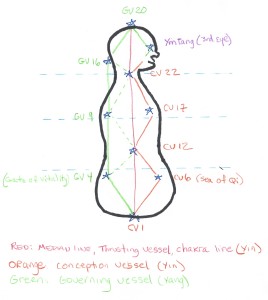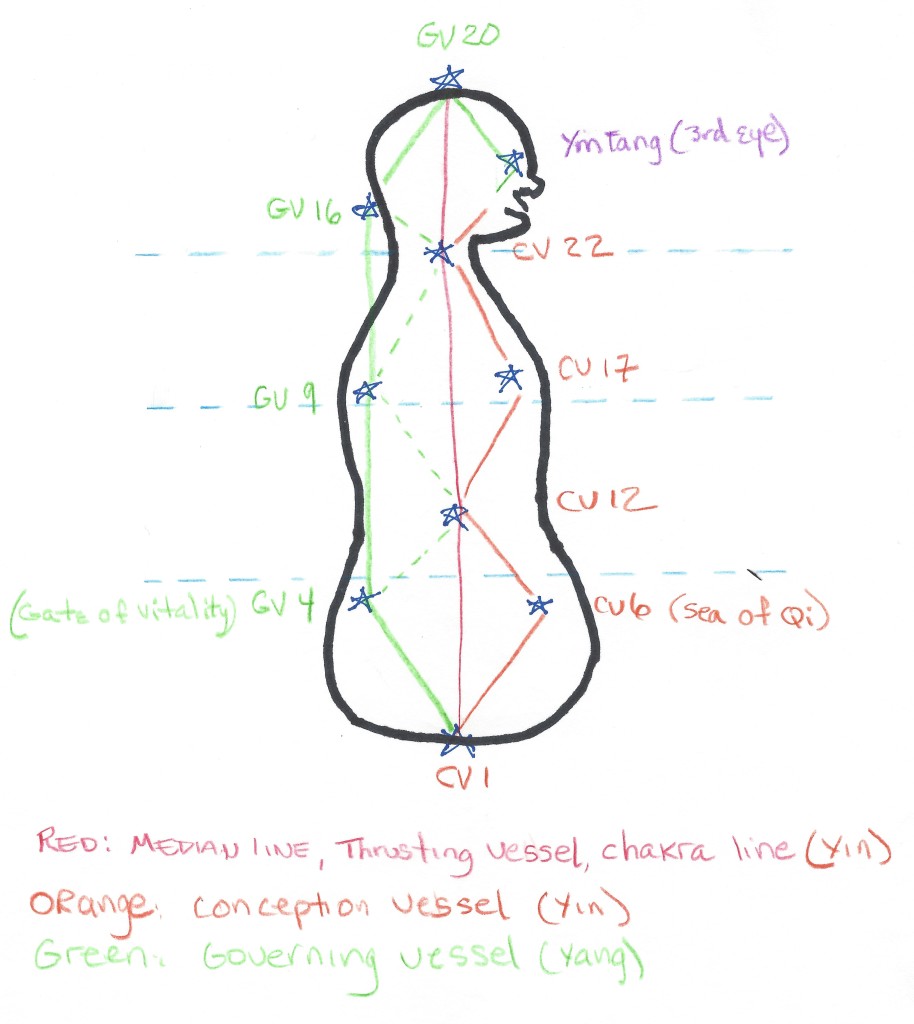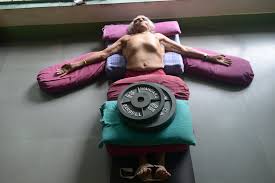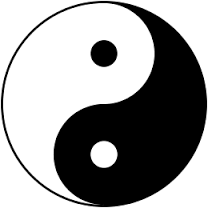 On the left we have our basic micro-cosmic orbit energetic pattern; two half circles joining to create a whole, with a diameter extending from root to crown, yin to yang. (Almost equal halves: the back circle, the yang governing vessel is slightly longer than the front, yin conception vessel. The meeting points are at the mouth and anus, the two ends of the gut body. How interesting! It is said that at birth, when a baby first opens her mouth to breathe, the circuit opens. The general practice is then to keep the energy field connected through all of the challenges of life.)
On the left we have our basic micro-cosmic orbit energetic pattern; two half circles joining to create a whole, with a diameter extending from root to crown, yin to yang. (Almost equal halves: the back circle, the yang governing vessel is slightly longer than the front, yin conception vessel. The meeting points are at the mouth and anus, the two ends of the gut body. How interesting! It is said that at birth, when a baby first opens her mouth to breathe, the circuit opens. The general practice is then to keep the energy field connected through all of the challenges of life.)
There are key points along the circle that we can focus on and bring energy to in order to active the whole, and we can link the points by moving our attention from point to point, using the breath. We can link the yin points to feel and find the conception vessel, or the yang points to find the governing vessel (GV-1 is just in front of the coccyx, on the other side of the anus from CV-1. We can also explore them as yin yang pairs such as GV-4 and CV-6, CV-17 and GV-9, or CV-1 and GV-20. The governing vessel nurtures the six yang channels and organs, while the conception vessel does the same for the yin channels and organs. This this circuit integrates the whole.
When we can hold yin and yang simultaneously, we have a ‘double action’. There may be waxing/waning as during movement, or staying stable, but yin and yang are always (when healthy) both dynamically engaged. (There are many more points of the governing and conception vessels that are used in acupuncture treatments. The ones on the diagram have been chosen by my teacher’s teacher, Jeffrey Yuen, to be of special importance in integrating the micro-cosmic orbit, which supports all the channels, and thus all the points. This is link offers an excellent introduction to Jeffrey’s cosmic level insight in teaching Chinese Medicine. )
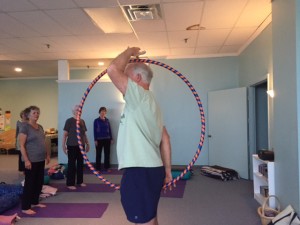 The acupuncture points (actually they are cavities, but it is much easier to bring your attention to a point rather than a cavity) are accessed through the skin, but their effects extend into the body, as well as into the energetic field surrounding the body. This allows us to visualize the larger circle as demonstrated by the hula hoop. Points CV-12 and CV-17 can be found at the center line of the body, along the thrusting vessel, even though they are listed as being on the front. Ultimately and ideally, all points are energized and energy flows freely in both directions around the circle, and up and down the center line. Reality tells us that energy gets sluggish in some places and overactive in others, so helping remediate this is a practice.
The acupuncture points (actually they are cavities, but it is much easier to bring your attention to a point rather than a cavity) are accessed through the skin, but their effects extend into the body, as well as into the energetic field surrounding the body. This allows us to visualize the larger circle as demonstrated by the hula hoop. Points CV-12 and CV-17 can be found at the center line of the body, along the thrusting vessel, even though they are listed as being on the front. Ultimately and ideally, all points are energized and energy flows freely in both directions around the circle, and up and down the center line. Reality tells us that energy gets sluggish in some places and overactive in others, so helping remediate this is a practice.
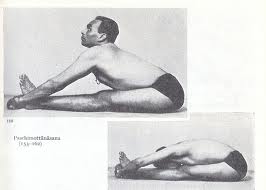 The micro-cosmic orbit is a sagittal plane circle and can be very helpful in guiding our movements in and out of forward and backbends. This is the foundational action in all of B.K.S. Iyengars poses.
The micro-cosmic orbit is a sagittal plane circle and can be very helpful in guiding our movements in and out of forward and backbends. This is the foundational action in all of B.K.S. Iyengars poses.
In paschimottanasana, he first activates the yang-back body-governing vessel as the yin/front body/conception vessel yields and opens, front and back acting as a single whole. The front tends to collapse in going forward, so this awakening alleviates that. Then he completes the pose by transitioning, smoothly reversing yin and yang, front and back, releasing the yang back body governing vessel to create a deep yin forward bend. The movements in and out are a dynamic double action. When staying in the pose, the double action remains as energy flow as the physical body remains still.
Check out ‘Light on Yoga’ and you will see all his forward bends are shown this way. For a bonus, check out this youtube clip featuring Iyengar at the ripe old age of 59, when he was in his prime. This is what fully integrated embodiment looks like! Pay special attention to the expanding and condensing of his body, in the transitions, but also when he completes the poses.)
lf I go from tadasana to uttanasana and back again, I can create a similar field where I imagine the circle turning like a wheel, half way in one direction to get down, and the reverse to come back. Down the front and up the back to go down, down the back and up the front to come up. This is movement. I can also, in tadasana or any pose for that matter, without moving physically, move the energy in the same pattern, as if the hula hoop moves, but I don’t. I can also do both at the same time, if I just move the energy. The circles pass through each other and I can complete both circles over and over, just using imagination, attention and breath or qi. This is a double action. Two apparently opposite actions, working together to create a dynamic field of energized presence. I can do a similar double action transitioning in or out, or remaining in any pose. This sustains the pose in a dynamic field to minimize holding/contracting and collapse.
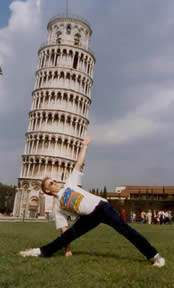 We also have a lateral plane circle that helps give us a three dimensional sense of embodiment. The common points are root and crown and the diameter, but now we have
We also have a lateral plane circle that helps give us a three dimensional sense of embodiment. The common points are root and crown and the diameter, but now we have 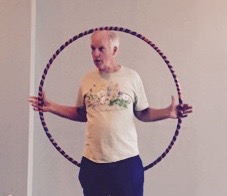 points on the sides of the body (our lateral line) to explore. This is the trikonasana circle or fish body. Balancing all points on the circle in both directions is the goal. I tend to collapse the underside, so I pay extra attention here, from inner back heel rooting into the ground all the way through the inner ear and beyond to keep the lateral circle open. Right and left are another yin/yang pair that communicate back and forth moment to moment, in transition, or in satying in the pose. Once I’ve landed in trikonasana and remain there for a while, I can explore the microcosmic orbit to stabilize front and back as well. The same principle operates in all of the lateral poses such as parsvakonasana, ardha chandrasana and anantasana and more.
points on the sides of the body (our lateral line) to explore. This is the trikonasana circle or fish body. Balancing all points on the circle in both directions is the goal. I tend to collapse the underside, so I pay extra attention here, from inner back heel rooting into the ground all the way through the inner ear and beyond to keep the lateral circle open. Right and left are another yin/yang pair that communicate back and forth moment to moment, in transition, or in satying in the pose. Once I’ve landed in trikonasana and remain there for a while, I can explore the microcosmic orbit to stabilize front and back as well. The same principle operates in all of the lateral poses such as parsvakonasana, ardha chandrasana and anantasana and more.
As a meditation, exploration and practice, I can zero in on any region of the body and refine the double action. We will use the pelvic floor as it holds the seat of the yin, the root chakra, and is the foundation for all postures. The two circles are shown as they cross at the pelvic floor. Imagine this is a bowl, so the lines are curved and the center point drops down (into the page from the reader’s perspective) creating a coccyx instead of the sacrum as one of the 4 cardinal points. Now we also have four quadrants or volumes to explore. (This is similar to the image shown in Bonnie’s video clip in the previous post.)
On the micro-cosmic orbit, in a forward bending action, or coming out of a backbend, (untucking) , the energy runs from pubic bone to coccyx, but if I a not careful, the energy may get stuck and I will just compress the front two quadrants. In a backbending action, or coming out of a forward bend, the energy runs from the pubis to the coccyx (tucking). My weakness will be to just close the back two quadrants and block the energy there.
Before I move into a pose, I can energetically move the coccyx and pubis together and apart, making the energy line connecting them longer or stronger. Or I can do both at the 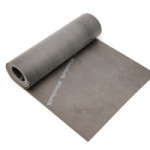 same time, as a double action. Try these now as you are
same time, as a double action. Try these now as you are 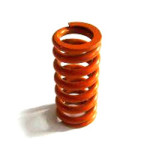 sitting reading this. To help get a feel for how the double action energy manifests in the tissue, Imagine either compressing a spring as it pushes back, or stretching thera-band as it offers resistance. Feel the dynamic charge of energy. You can modulate the intensity. Start strong and then back off until the the energy is very clear but subtle. Locate the intersection point and make sure it is centered. If you feel adventurous, add CV-6 and GV-4 to create longer arcs of energy. Imagine the whole circles as you focus on the lower bowl. Feel CV-6 and GV-4 parallel to the ground and CV-1 at absolute center. As this becomes stable, your ability to sit lightly will increase tremendously.
sitting reading this. To help get a feel for how the double action energy manifests in the tissue, Imagine either compressing a spring as it pushes back, or stretching thera-band as it offers resistance. Feel the dynamic charge of energy. You can modulate the intensity. Start strong and then back off until the the energy is very clear but subtle. Locate the intersection point and make sure it is centered. If you feel adventurous, add CV-6 and GV-4 to create longer arcs of energy. Imagine the whole circles as you focus on the lower bowl. Feel CV-6 and GV-4 parallel to the ground and CV-1 at absolute center. As this becomes stable, your ability to sit lightly will increase tremendously.
Hip Remediation:
I have been working with some issues in my right hip for several years now thanks to some unfortunate encounters with ice dams and window wells my last winter in Arlington. What has been most helpful is to bring this double action I feel on the microcosmic orbit first into my spine/pelvis and then into the hip joints. In what ever hip-opening pose I am working with, I first monitor the 4 orquadrants of the pelvic floor, noticing which quadrants are compressed or overstretched. Because the legs attach to the pelvis, they affect the pelvic floor and vice versa. My right rear quadrant of the pelvic floor is the major culprit in my hip challenge, and I can connect that to the other three to help provide support in releasing.
Now imagine each hip joint has four quadrants in the same plane as the pelvic floor and monitor those. When seated, the pelvis is now 90 degrees to the femurs and I now have a second floor to add to the four rooms of the first (pelvic) floor. Instead of four quadrants, I now have eight volumes or spaces. These are composed of the yin and yang pairs of each combination of the three directions: lower front right, lower front left, upper front right, etc. Ramanand calls the upper front rooms the tops of the groins, from the acetabula up the illium, and the bottom front rooms, the bottom of the groins, from the acetabula to the sitting bones.There are four more spaces at the back of the hips as well.
To bend forward moving from the pelvis, whether sitting or standing, what I want to do is open the bottom of the groins, from the acetabulum to the sitting bones, and the bottom back hips as well, and release into this space.In coming out of a forward bend, which is the same actions as going into a backbend, I want to open the upper stories, front and back. In backbends, lengthening the tail is very useful in keeping the upper back space from contracting.
If I truly want to ‘open’ the hip joint and engage all eight spaces, I can simultaneously, energetically roll the head of the femur in the opposite direction of the acetabulum. In a forward bend, the acetabulum untucks (pubis to coccyx, down the front and up the back) while the femur ‘tucks’ coccyx to pubis, down the back and up the front. This is bringing the microcosmic orbit into the action of bones and flesh. This is creating a double action with the femur head and the acetabulum, paralleling the double action of the microcosmic orbit through the pelvic floor.
In supta padangusthasana like poses, the femur head of the lifting leg moves around the socket, but the 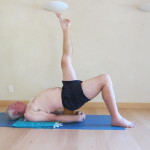 energetic action is the same as uttanasana. The femur head feels as if it were ‘tucking’ while the socket continues to untuck. When the motion is complete, I sustain the double action energetically to melt the joint. Start with the micro-cosmic orbit to engage the whole. Focus in on the four quadrants of the pelvic floor, and then add the upper and lower spaces. Then focus even more closely on the actions of the femurs and acetabula. When you find a sense of balance, rest in the infinite space that feeds the yin and yang. This is dynamic somatic meditation in action.
energetic action is the same as uttanasana. The femur head feels as if it were ‘tucking’ while the socket continues to untuck. When the motion is complete, I sustain the double action energetically to melt the joint. Start with the micro-cosmic orbit to engage the whole. Focus in on the four quadrants of the pelvic floor, and then add the upper and lower spaces. Then focus even more closely on the actions of the femurs and acetabula. When you find a sense of balance, rest in the infinite space that feeds the yin and yang. This is dynamic somatic meditation in action.


